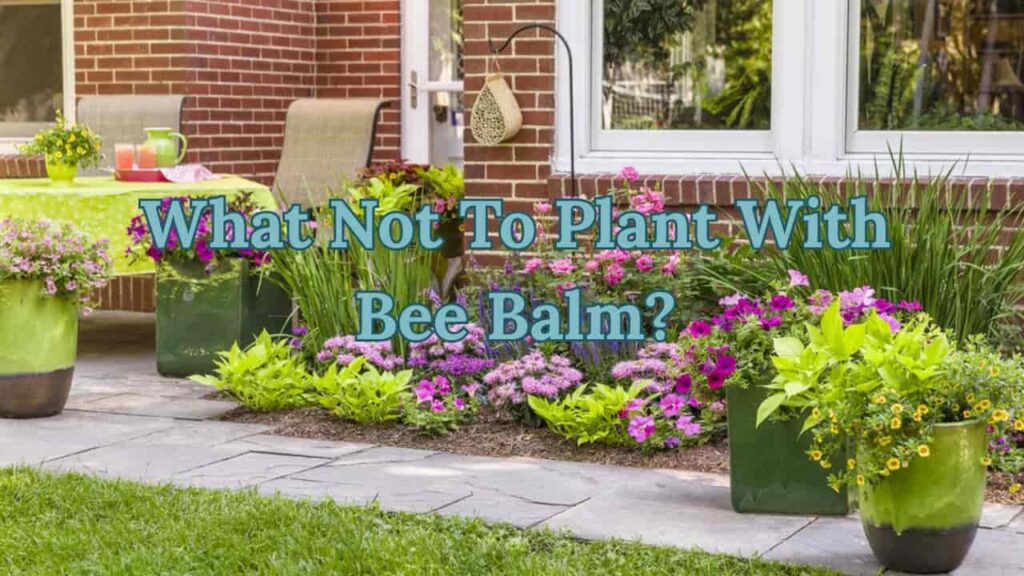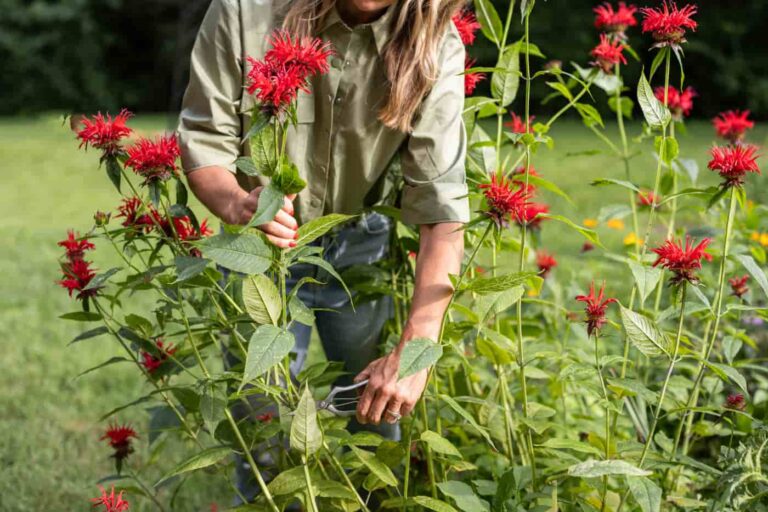Bee Balm can greatly contribute to the garden’s beauty and ecosystem. Many gardeners love it for its bright, showy blooms, and its ability to attract pollinators like bees, butterflies, and hummingbirds.
But, when it comes to it’s healthy growth, knowing what not to plant with bee balm is extremely important.
Depending on what companion plants you choose, it can be both beneficial or harmful for the garden. By placing bee balm near the right companion plants, you can help them grow healthy and beautiful.
But the wrong companion plants for bee balm can lead to problems like aggressive spreading, mildew growth, and create a competition for nutrients among plants.
In this post, that’s exactly what we are going to discuss today – what you shouldn’t plant with bee balm for effective and healthy growth. Moreover, we will also discuss what to plant with bee balm. And, finally will share some of the tips that will help you grow your bee balm without any issues.
What Not To Plant With Bee Balm? (For Healthy Growth)

When planting bee balm, it’s important to be mindful of what companion plants you are planting near it. There are some plants that you shouldn’t plant with bee balm. Having them creates problems like aggressive spreading, mold growth, or improper nutrient distributions among plants.
In this section, we are going to explore what plants you should avoid with bee balm and what kind of problems they can create in your garden. It’s best to avoid these problematic pairings to ensure a healthier and more balanced environment.
Aggressive Invaders
Bee Balm is an aggressive spreader, it spreads quickly through rhizomes, potentially choking out the small delicate plants. So, it’s best to avoid pairing it with other invasive plants, as it can lead to overcrowding and resource depletion.
So, to maintain a balance in your garden, it’s best to keep your bee balm away from these fast spreading invader plants:
- Barberry
- Bungleweed
- Burning bush
- English ivy
- Chinese wisteria
- Privit
- Kudzu
- Lantana
- Oriental Bittersweets
- Sweet Autumn Clematis
Heavy Feeder plants
Bee balm thrives in nutrient rich soil and pairing it with heavy feeders can cause improper distribution of nutrients among plants.
Heavy feeders like corn, cabbage, cucumber, and tomatoes, need large amounts of nutrients, especially nitrogen, to grow properly.
This competition of nutrients can weaken all plants, affecting their overall health and growth. So it’s best to avoid planting these heavy feeder plants around bee balm:
- Corn
- Cucumber
- Pepper
- Melons
- Squash
- Sunflowers
- Tomatoes
- Zucchini
Plants Prone to Powdery Mildew
Bee balm can easily catch mildew, especially if you live in humid conditions with poor air circulation. So, it’s best to avoid pairing the bee balm plants with mildew prone plants like garden phlox, zinnias, lilacs, and roses.
This can increase the risk of fungal infection spreading throughout your garden. There will be some kind of white spots on the leaves of bee balm if it’s affected.
So, if you want to keep your plants healthy, it’s best to avoid pairing it with plants that are prone to mildew problems. Here are some of the plants that are prone to powdery mildew:
- Garden Phlox
- Zinnias
- Squash
- Roses
- Lilacs
- Cucumbers
- Delphinium
- Crab apple trees
Shade-Loving Plants
Bee balm grows well in partial and it flourishes in full sunlight. It needs at least six hours of direct sunlight daily.
So, pairing it with plants that love shade like ferns, buckthorn, and clematis, can create problems in their growing conditions.
It’s best to keep the plants that prefer cool, shaded environments away from bee balm, as placing these two together can result in poor growth and stress.
Here are some shade loving plants that you should keep bee balm from:
- Clematis
- Flowering Dogwood
- Buckthorn
- Weeping podocarpus
- White spruce
- Southern live oak
- Pyracantha
Vegetables that divert nutrients away
There are some vegetable plants that are heavy feeders and can take all the essential nutrients from the soil, causing bee balm to struggle.
There are some plants like tomatoes, peppers, corn, that require large amounts of nitrogen and other nutrients from the soil to grow. This will cause nutrient deficiency in bee balm.
So when planting bee balm, try to avoid these vegetable plants:
- Corn
- Melons
- Tomatoes
- Beets
- Broccoli
- Cabbage
- Carrots
- Radish
Plants That Prefer Dry Conditions
Bee balm loves evenly moist soil so planting plants that love dry conditions near them aren’t a very good companion for them.
Plants like succulents, lavender, sedum, and russian sage prefer dry, well drained conditions but they may not survive if they are planted near bee balm.
If there’s too much moisture, it can lead to root rot in these plants, but if the soil is too dry, bee balm will suffer.
So when choosing a spot for bee balm, go where there’s a good humidity level and also have good air circulation.
Herbs
There are some herbs that can grow well beside bee balm, since it also belongs to the mint family but there are a few exceptions. Since bee balm is an aggressive spreader, it competes with other mint plants for nutrients, water, sunlight, and space because bee balm roots grow quite long.
There are some herbs that aren’t a very good companion to bee balm. If you want your plants to thrive, it’s best to plant them where the conditions are favorable to their growth.
Here’s the list of herbs that you should grow somewhere else:
- Apple mint
- Chocolate mint
- Orange mint
- Peppermint
- Spearmint
- Wild mint
- Pineapple mint
What to plant with bee balm? Best Companion plants
By choosing the right companion plants for bee balm, you can improve the quality and life of your plants.
There are many plants and shrubs that pair well with bee balm. With the right companion plants, you can enhance the plants’ growth, improve garden health, and attract beneficial pollinators for them.
You just need to choose those who’s growing conditions are the same as the bee balm. You can go for flowers like coneflower, black eyed susan, coral bells, milkweed, and yarrow.
Here’s the complete list of best companion plants for bee balm:
Echinacea (Coneflower)
- Attracts pollinators like bees and butterflies, complementing bee balm’s appeal.
- Similar sun and soil needs; adds structural contrast with sturdy stems.
Rudbeckia (Black-Eyed Susan)
- Bright blooms pair well with bee balm’s vibrant colors, extending garden interest.
- Drought-tolerant and low-maintenance, thriving in similar conditions.
Salvia
- Spiky flowers contrast bee balm’s rounded blooms, attracting hummingbirds and bees.
- Prefers well-drained soil and full sun, aligning with bee balm’s needs.
Phlox
- Adds fragrance and color variety; attracts pollinators.
- Shares bee balm’s preference for moist, well-drained soil and partial shade tolerance.
Lavender
- Repels pests like aphids while attracting beneficial insects.
- Prefers slightly drier soil but adapts to bee balm’s conditions in well-drained beds.
Yarrow (Achillea)
- Enhances pest resistance and attracts predatory insects like ladybugs.
- Drought-tolerant and thrives in full sun, complementing bee balm’s vigor.
Catmint (Nepeta)
- Deters pests like flea beetles and adds soft, mounding foliage.
- Shares bee balm’s sun and soil preferences, creating a lush border.
Asters
- Blooms later than bee balm, extending the flowering season.
- Attracts pollinators and thrives in similar conditions.
Coreopsis
- Bright, daisy-like flowers add color harmony; low-maintenance.
- Tolerates poor soil and full sun, matching bee balm’s adaptability.
Liatris (Blazing Star)
- Spiky blooms add vertical interest and attract butterflies.
- Prefers well-drained soil and full sun, aligning with bee balm.
And if you want to plant herbs then you can go for basil, lavender, rosemary, thyme, chives, and lemon balm.
You can also plant vegetables, just make sure they are light feeders like artichokes, beans, lamb’s lettuce, and turnips.
Best Companion Plants For Bee Balm in Containers
Bee balm is great for decorating your garden and making it more visually appealing. You can place them in containers to make the space look more inviting.
It’s quite easy to grow bee balm in containers and turn them into a pollinator friendly zone. So, when you are growing bee balm in containers, you need to select a few filler plants as well. And those plants need to be compatible with bee balm or else there will be no blooming.
You can use filler plants like supertunia, petunias, calibrachoa, and trailing verbena, they look amazing with bee balm and grow beautifully with it.
You can also choose perennials like coneflower and black eyed susan, they have the same growing conditions as the bee balm.
This way you will be able to maintain aesthetics and also the health of plants. You can also add yarrow, this is great to enhance the quality of the soil and attract beneficial pollinators.
With these combinations, you can create a vibrant looking container garden that not only looks good but supports biodiversity too.
Conclusion
Choosing the right companion plant for the bee balm is very important. There’s no doubt that bee balm is beneficial to a garden and adds charm to it with its beautiful vibrant colors.
But, at the same time, it’s also important to know what not to plant with bee balm, as wrong companion plants can create issues like overcrowding, competition for nutrients, and mold growth.
By understanding bad companions for bee balm, you can extend the life of your garden and enhance the health of your plants.
You just need to simply go for those plants or herbs that actually share the same growing conditions as the bee bee balm plant.
There are some amazing companion plants like coneflower, black eyed susan, moisture loving herbs, and thyme.
This way you can create a balanced, pollinator friendly environment for your plants where they can grow beautifully without any problem.
Frequently Asked Questions(FAQs)
Yes, bee balm can choke out other plants because it spreads aggressively due to it’s rhizomes and stolons. It can quickly take over the garden beds, compete for space, water, sunlight, and nutrients. You need to create balance by choosing plants that share the same growing conditions as the bee balm. You need to do regular pruning and maintain spacing between plants, which can help control its spread.
While bee balms are attractive and beneficial for pollinators, they also have some drawbacks too. It spreads fast through rhizomes, prone to mildew in very humid conditions and poor air circulations. And not only this, they do attract pollinators but they also attract unwanted pests like aphids and spider mites. It can take over weak plants because of competition for nutrients and water.
The answer to this is simple, you just need to go for plants that share the same growing conditions as the bee balm. And avoid plants that need dry soil or spread too fast. Choosing the right plants will help bee balm grow strong and keep your garden healthy and beautiful.
Avoid planting bee balm where there is poor circulation or it’s shaded from sunlight because bee balm needs space to grow its roots and good amount of sunlight. And avoid overcrowding the garden where it might take over the small weak plants nutrients and stop them from growing. Make sure the soil is moist, rich in nutrients, has a good sunny spot, with enough space to spread.



